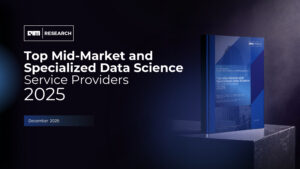Differentiating between human-created and AI-generated content has grown increasingly challenging in the digital age. As AI, such as GPT-3, evolves, it can produce text, images, and videos that closely mimic human work. To discern the origin, one must consider factors like consistency, errors, style, and tone. Human-made content often exhibits subtle variations and personal nuances, whereas AI can lack these attributes. The volume and speed of content generation, along with metadata analysis, provide additional clues. Maintaining vigilance and critical thinking is crucial in navigating the blurred line between human and AI-created content in our information-driven world.
To dwell more on this we had a roundtable discussion on the agenda “How do we differentiate between human-made and AI-generated content”. The session was moderated by Sudha Bhat, Senior Director, Solution Strategy – Conversation Analytics at Uniphore with panelists Satyam Priyadarshy, First Chief Data Scientist – Oil and Gas Industry, Deepika Kaushal, Head-Everyday AI & Digital analytics at Piramal Capital & Housing Finance, Nithya Subramanian, Head of Data & Analytics – AMEA at Kellogg Company, Moutaz Gendia, Global Associate Director for Reporting and Analytics- Commercial at Novartis, Varun Saxena, Sr. Vice President & Head AI ML at ANAROCK and Vani Arora, Vice President at Macquarie Group.
Identifying AI-Generated Content
As a professor, when I read a student’s article that I know, I have an idea about that person. I’ve been teaching for some time. So I know what they are capable of writing, and ChatGPT is very easy to figure out. It’s almost like cheating, if you think of it. The second thing is that if you really want to use some technology, you can actually look at the readability index of those articles. When we write articles, if you look from statement to statement or paragraph to paragraph, our readability index will change. But when you write through a Chat GPT, it is pretty much the same readability index for the whole set. Therefore, one figuring it out, in what context we are doing; second, looking at some basics, and if you actually mix it with the behavioural analytics of the person, then it’s actually very easily distinguished.
If you look at latest topics, whatever could be AI or quantum computing or some other topic in India, like politics, if you read those articles, if they are written through machines, or algorithms, you will see they’re not actually coherent. You will see that this was not thought out. So as a reader, I think it’s very easy to figure it out.
– Satyam Priyadarshy, First Chief Data Scientist – Oil and Gas Industry
We’ll be able to figure out whether it is too grammatically correct or having a very formal language in place. It is easier to identify whether this is Chat GPT related content. I think there are certain tools, like GPT zero, through which it will be easier to identify than eyeballing all the time.
So in terms of getting into a more human format, I think it’s not happening with Chat GPT right now. That is an easier catch.
– Deepika Kaushal, Head-Everyday AI & Digital analytics at Piramal Capital & Housing Finance
AI’s Role in Generating Human-Like Text
AI has been really helping us in different ways in our commercial applications and also in case of pricing optimization. The need for differentiating between machine generated versus human generated, I somehow feel that it is a bit counterintuitive to the original effort of generating AI itself. We have generative AI for what? To generate human-like text, if it is not generating human-like text that means it is not doing right. We will then have to see in which areas it is important to differentiate between human generated versus AI generated work, maybe in case of research or in art, or things like that. There is no way to verify whether a machine generated is different from a human generated, you’re asking your machine to do that, which again is another counterintuitive argument. It has to be a human looking at two different texts and identifying because the human is going to use something called a Sentience, which a machine will never have.
– Nithya Subramanian, Head of Data & Analytics – AMEA at Kellogg Company
Balancing the Roles of Generative AI
Generative AI is like the invention of the calculator for me. The way we would measure, say excellence is by mental math, and then came the calculator and now it’s not more about being able to use mental math, but the ability to use the calculator to do more advanced calculations. So I’m not against having generative AI being able to generate text. The question is where and if looking in the pharma industry, a highly regulated industry, it becomes a very critical point. I wouldn’t want to get medical advice from a Gen AI, especially that it might not be as accurate as a human. If we’re having a marketing stunt, you know, slogan or campaign, then you can actually do more through Generative AI in reaching the market faster, inferring those insights. As generative AI gets even more sophisticated, we can actually get information faster. But still the prompting, the critical thinking, the creation of the ideas still has to have the human touch, because AI will always look at the past and recreate but will not be able to get the creative aspects. So I would say things that are very concrete, like clinical trials, doctor’s recommendations, maybe regulatory affairs, where we need to know things about the products, definitely the use of Gen AI would be limited or currently railed heavily. But at the same time for creativity, competitiveness, and the commercial side it is very useful.
– Moutaz Gendia, Global Associate Director for Reporting and Analytics- Commercial at Novartis
The Impact of Generative AI on Marketing and Consumer Engagement
After Chat GPT, the copy of ads looks much better. You don’t find grammatical mistakes. Go to any in house or marketing agency. You ‘ll find that everyone today uses Chat GPT, to give a better output. So it’s helping. So ideally, in the marketing field, it’s helped. You really don’t need a person seeing a Facebook ad to identify whether it is Gen AI generated or human made. If he likes it, he’ll click on it and move ahead. There will be places where a mix may be required, like where people know it’s a bot or a machine, but they’re okay with it. The youngsters today don’t want to interact too much with humans. They are really comfortable with talking to machines and interacting with them. The challenge really comes in for 32 – 55 years old, where they have seen both worlds. They are also the decision makers of today. In real estate, 80% of the homebuyers are from 30-45 years of age. When I reach out to 40 to 45 years old, I go for manual interaction or human interaction whereas for 30-35 years old, I approach them through personalized IVRS depending on where they are in their sales journey.
– Varun Saxena, Sr. Vice President & Head AI ML at ANAROCK
Optimizing Efficiency and Security
Talking about the financial sector, it is a highly regulated sector. We have seen immense benefit coming out from the huge data that we have, and using machine learning on top of it and seeing how we can catch instances of irregular behavior. A combination of a rule based model with the machine learning models, it has been seen to be really impactful in terms of reducing the load.
– Vani Arora, Vice President at Macquarie Group
In Conclusion,
There are three main takeaways one, you should be looking at human content and AI generated content from a perceivers side as well. So that you are able to differentiate and allow generative AI to actually be your arm of support. The second important point, if the job of generative AI is to be human-like, let it do it. Use it to the maximum and then get it right. The third takeaway is that we can definitely all excel ourselves, keep looking at how you can improve as part of the different industries. Maybe we are not harnessing it as much as we can because there’s so much groundwork involved in terms of the data and infrastructure, which is a continuous process.
– Sudha Bhat, Senior Director, Solution Strategy – Conversation Analytics at Uniphore
This article is written by a member of the AIM Leaders Council. AIM Leaders Council is an invitation-only forum of senior executives in the Data Science and Analytics industry. To check if you are eligible for a membership, please fill out the form here.






